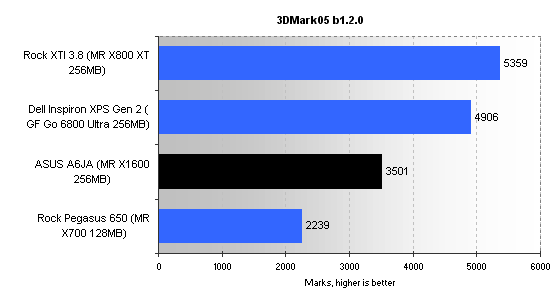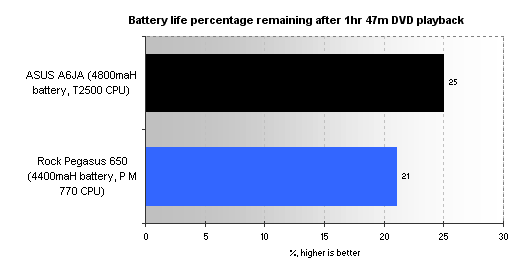Gaming and battery life
The ASUS A6JA ships with an ATI Mobility Radeon X1600 256MB PCI-Express card that's clocked in at 450MHz core and 700MHz memory. Being an X1000-series card it carries ATI's Avivo technology and an efficient architecture that's helped by a ring-style memory controller and parallel threading dispatch. It's a sensible choice for a laptop featuring a WXGA (1280x800) panel and, on paper, should allow you to play most games, smoothly, at the screen's native resolution.We've also added in results from a Rock Pegasus 650 laptop, featuring an overclocked Pentium M 770 (running at 2.24GHz) and ATI Mobility Radeon X700 128MB PCIe graphics card, the SKU that's effectively replaced by the MR X1600.



We didn't expect a midrange graphics card to challenge the previous generation's top-end mobile offerings from ATI and NVIDIA, both of which are housed in the desktop-replacement laptops from Rock and Dell, respectively. Run at the panel's native 1280x800 resolution returned results which were around 30% lower than those at 1024x768. DOOM 3 was a little sticky in high-quality mode but Far Cry, set to very high quality, was smooth enough to play without undue slowdown. Given the results above, the choice of mobile GPU is a decent one.
Battery considerations
A very simple test was run to gauge mobile battery life from a fully charged source. The ASUS A6JA was set to playback a 107-minute DVD, in full-screen mode and from the laptop's DVD drive, with screen brightness turned down to medium, battery mode set to maximum efficiency, and wireless connectivity switched off. After completion, we monitored just how much of the battery life was remaining. Granted, it's not the most system-intensive task, but it should give you an idea of power-related optimisations from a Napa-based notebook.

Pretty much on a par with a notebook featuring a single-core Pentium M, reasonably similar graphics card, and a similar battery capacity. Yonah packs in two execution cores and around 10% more transistors than a similar Dothan Pentium M CPU, so battery life is actually pretty good.









